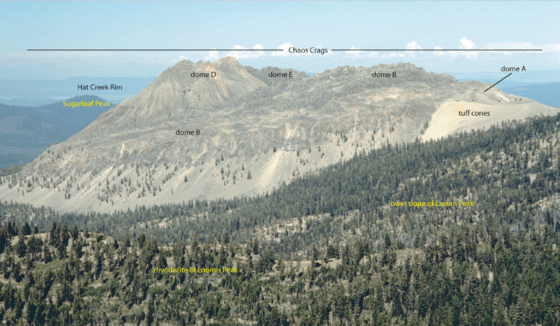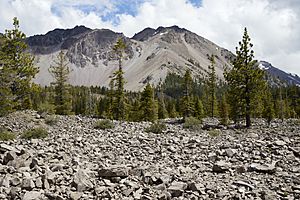Chaos Crags facts for kids
Quick facts for kids Chaos Crags |
|
|---|---|
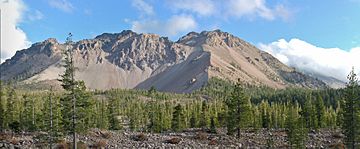
Chaos Crags with Chaos Jumbles below.
|
|
| Highest point | |
| Elevation | 8,448 ft (2,575 m) |
| Prominence | 581 ft (177 m) |
| Geography | |
| Location | Lassen Volcanic National Park, Shasta County, California, U.S. |
| Parent range | Cascade Range |
| Topo map | USGS Manzanita Lake |
| Geology | |
| Age of rock | Holocene |
| Mountain type | Lava domes |
| Volcanic arc | Cascade Volcanic Arc |
Chaos Crags is a group of young lava domes in Lassen Volcanic National Park, California. These domes are like big, rounded hills made from thick, sticky lava. They formed about 1,100 to 1,000 years ago. One of the domes even collapsed during a powerful eruption about 70 years later.
The Chaos Crags are special because their eruptions are some of the only ones to happen in the Lassen area in the last 11,700 years. You can find them north of Lassen Peak. They are part of the Cascade Range, a chain of volcanoes in Northern California. Every year, a small lake forms at the bottom of the Crags. It usually dries up by the end of summer.
Right next to the Crags, stretching towards the northwest, is an area called Chaos Jumbles. This is a huge rock avalanche that happened about 300 years ago. Rocks slid down the mountain at about 160 kilometers per hour (100 miles per hour)! They moved so fast partly because they rode on a cushion of compressed air. The sliding rocks knocked down trees and blocked Manzanita Creek, which created Manzanita Lake.
Scientists study Chaos Crags to understand its past. They also watch for any signs of new activity. Future eruptions could create new lava domes or send out ash and hot rock flows. There's also a risk of more rockfalls. These studies help keep visitors safe.
Contents
What are the Chaos Crags?
The Chaos Crags are part of the Cascade Range in Northern California. They are located in the northwest corner of Lassen Volcanic National Park. This is in Shasta County. The Crags are about 3 kilometers (2 miles) north of Lassen Peak. They stand about 2,575 meters (8,448 feet) tall. The park itself is surrounded by the Lassen National Forest.
A temporary lake forms at the base of the Crags each year. It's called Crags Lake or Chaos Crater. This lake fills up with melted snow in the spring. The water is cool near the edges and colder in the middle. It usually disappears by late August.
How the Crags Formed
The Chaos Crags are made of a type of lava called rhyodacite. They are the youngest lava domes in the Lassen area. They started forming about 1,100 years ago. First, there were explosive eruptions of pumice and ash. Then, thick lava slowly oozed out, building up the domes.
Sometimes, parts of these new domes would collapse. This created fast-moving flows of hot rock and gas called pyroclastic flows. These eruptions were very powerful. They were about 100 times stronger than the Lassen Peak eruptions in 1915.
Originally, six domes formed. But about 70 years later, one of them was destroyed. A violent eruption caused it to collapse. This created more pyroclastic flows and ash. Today, five domes remain. Two of them have had smaller landslides.
The eruptions at Chaos Crags are important. Along with Cinder Cone and the 1914–1921 eruptions of Lassen Peak, they are the only recent volcanic events in the Lassen area. Scientists believe the magma for these eruptions came from the same deep underground chamber. This chamber has been recycling old magma for thousands of years.
Unlike Lassen Peak, which has been shaped by glaciers, the Chaos Crags look very sharp and rugged. They haven't been worn down by ice.
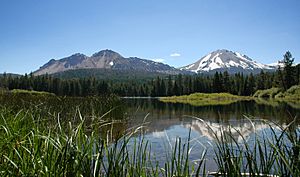
The Chaos Jumbles
About 350 years ago, one of the Chaos Crags domes collapsed. This caused the Chaos Jumbles. It was a series of three huge rockfalls. The rocks traveled about 6.4 kilometers (4 miles) down the mountain. Scientists aren't sure what caused it. It might have been an earthquake.
The largest rockslide even moved 120 meters (400 feet) up nearby Table Mountain! It then turned and moved west. The rocks moved very fast, around 160 kilometers per hour (100 miles per hour). They slid partly on a cushion of compressed air. This reduced friction.
The Chaos Jumbles covered about 11.6 square kilometers (4.5 square miles) with volcanic rocks. This rockfall also blocked Manzanita Creek, creating Manzanita Lake. The jumbled rocks have made it harder for soil and trees to grow there.
Watching for Dangers
Scientists from the United States Geological Survey (USGS) keep a close eye on Chaos Crags. They know that past events here were very powerful. Pyroclastic flows from the Crags once reached areas where parts of the Manzanita Lake visitor center now stand.
If Chaos Crags became active again, it could cause new dangers. These include pumice eruptions, pyroclastic flows, or sudden rockfalls. While new lava domes might form, they wouldn't be a huge threat if people left the area quickly. Pyroclastic flows could travel far into nearby valleys. The spread of ash would depend on the wind.
However, rockfalls are more dangerous. They can happen without warning. They could seriously endanger anyone within 5 kilometers (3 miles) of the Crags.
To monitor the area, the USGS uses GPS receivers. These have been in place since 2008 to detect any ground movement. There are also 13 seismometers nearby. These were first installed in 1976 and are updated regularly. They constantly check for earthquakes.
Plants and Animals
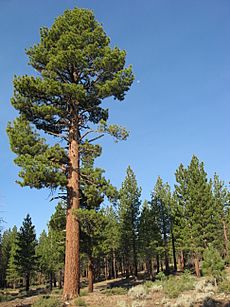
The Chaos Jumbles area is unique. Unlike other places after a volcanic event, it didn't have many small plants grow first. Instead, conifer trees like pines started growing right away. Crags Lake is home to tadpoles and many frogs. Around the lake, you'll find sugar pines, white firs, and Jeffrey pines. There's also a small chokecherry tree.
Lassen Volcanic National Park has many different forests. You can see red fir, western white pine, lodgepole pine, and ponderosa pine. Other plants include lupines, ferns, and various shrubs.
The park is home to about 300 types of animals with backbones. These include mammals, reptiles, amphibians, fish, and birds. You might spot bald eagles, which are a protected species. Peregrine falcons also live here.
In the lower forests, you can find American black bears, mule deer, and martens. Birds like brown creepers and mountain chickadees are common. Higher up, you might see Clark's nutcrackers and chipmunks. In rocky areas, look for pikas and golden-mantled ground squirrels.
Meadows near streams and lakes are home to Pacific tree frogs and Western terrestrial garter snakes. Other animals in the park include different types of snakes, cougars, and various amphibians. There are 216 bird species, including spotted owls. The park also has five native fish species and four invasive ones. You might also see California tortoiseshell butterflies.
History of the Area
People have known about the Chaos Crags for a long time. They were first observed by explorers Brewer and King in 1863. The name "Chaos Crags" became official in 1927.
Scientists started studying the Crags in the late 1920s. Howel Williams wrote about the rock deposits and eruptions. He first thought the landslides happened about 200 years ago. Later studies by James P. Heath suggested they were between 300 and 1,500 years old.
In 1974, the National Park Service closed the visitor center at Manzanita Lake. They were worried about rockslides from Chaos Crags. But in the 1980s, scientists realized the danger had been overestimated. So, in 2011, twenty wooden cabins were brought back to the Manzanita Lake Campground. Visitors can now rent them again.
Fun Things to Do
The Chaos Crags and Crags Lake Trail is a great way to explore the area. It's about 6.7 kilometers (4.2 miles) long, round-trip. The hike takes about three hours. It starts at Manzanita Camp Road and goes through a forest next to the Jumbles.
The trail climbs about 260 meters (850 feet). You'll get amazing views of the Jumbles and the Crags. You can also see the Hat Creek valley and the Thousand Lakes Wilderness. After about 2.7 kilometers (1.7 miles), you'll reach Crags Lake. You can swim there, but the lake is small, so conditions might not be perfect.
Even though it's easy to get to, not many people visit this area. There's also another 2.6-kilometer (1.6-mile) trail that goes around Manzanita Lake.


